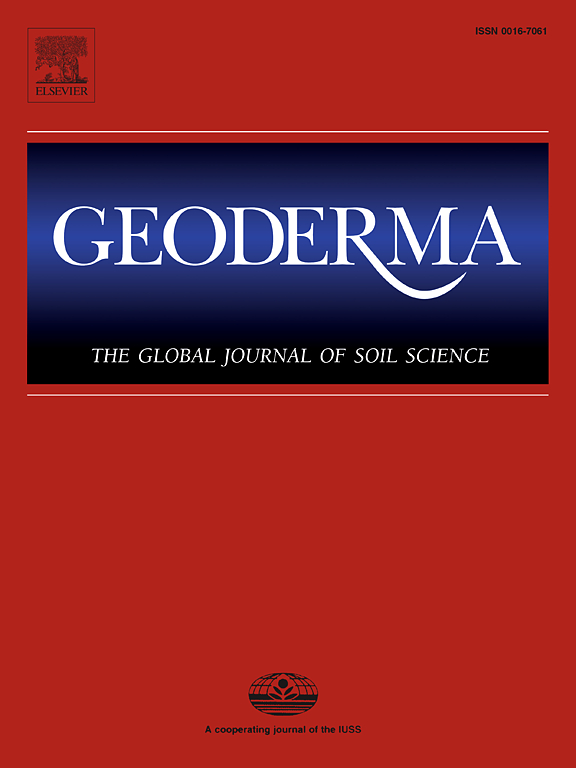黄土高原丝根和纤维根草地土壤抗侵蚀能力的季节变化
IF 5.6
1区 农林科学
Q1 SOIL SCIENCE
引用次数: 0
摘要
植被生长可以引起生长季土壤抗蚀性的季节变化,反映在细沟可蚀性(Kr)和临界剪应力(τc)上。然而,对不同根型草地抗蚀性的季节变化进行量化研究的研究较少。研究了黄土高原根系和纤维根系草地土壤抗侵蚀能力的季节变化,量化了土壤抗侵蚀能力的潜在影响因素。未受干扰的土壤样本于2021年4月至9月每隔30天采集一次。在固定河床的水力水槽中,测定了6种剪应力作用下的集中流脱土能力,以确定土壤的抗侵蚀能力。结果表明:一年生草本植物的Kr随生长季节呈幂函数递减,且一年生草本植物的Kr下降速度快于多年生草本植物。与对照土相比,草地的Kr降低了4.07 ~ 95.78%,τc增加了141.26 ~ 176.35%。一年生草本植物的Kr比多年生草本植物高11.58倍,τc比多年生草本植物低15.48%。在丝根和纤维根之间也观察到Kr的差异。丝状根系植株的Kr较高,是纤维状根系植株的2.83倍。根系和土壤对Kr和τc的贡献率分别为41.1%和3.4%,τc对根系和土壤的贡献率分别为9.1%和18.8%。Kr随根质量、根长和表面积密度的增加呈指数递减,随容重、黏聚力和水稳性骨料含量的增加呈指数递减。τc以幂函数形式随体积密度的增大而增大。最后,利用水稳性团聚体含量和根表面积密度对Kr进行了有效预测。所建立的模型性能令人满意(NSE = 0.85)。本文章由计算机程序翻译,如有差异,请以英文原文为准。
Seasonal variations in soil erosion resistance under tap and fibrous root systems grasslands on the Chinese Loess Plateau
Vegetation growth can induce the seasonal variation in soil erosion resistance during a growing season, reflected by rill erodibility (Kr) and critical shear stress (τc).
However, few studies have been conducted to quantify the seasonal variations in erosion resistance under different root type grasslands. This study was conducted on the seasonal variations in soil erosion resistance under tap and fibrous root systems grasslands on the Chinese Loess Plateau, and quantified the potential influencing factors of soil erosion resistance. The undisturbed soil samples were collected over 30-day intervals from April to September 2021. Soil detachment capacity by concentrated flow was measured in a hydraulic flume with the fixed bed under six shear stresses to determine soil erosion resistance. The results showed that the Kr decreased over the growing season as a power function, and the Kr of annual herbaceous plants decreased faster than that of perennial herbaceous plants. Compared with the bare control soil, the Kr of grasslands decreased by 4.07–95.78 %, τc increased by 141.26–176.35 %. Generally, the Kr of annual herbaceous plants was 11.58 times higher, and τc was 15.48 % lower than perennial herbaceous plants. Differences in Kr were also observed between plants with tap and fibrous root systems. Plants with tap root systems had a higher Kr, which was 2.83 times that of plants with fibrous root systems. Plant root systems and soil were all affected in terms of Kr and τc, root system and soil contributions were 41.0 and 3.4 % for Kr, and 9.1 % and 18.8 % for τc, respectively. In addition, Kr decreased exponentially with increasing root mass, length, and surface area density, and also decreased with increasing bulk density, cohesion, and water-stable aggregate content. The τc increased with increasing bulk density as a power function. Finally, Kr was effectively predicted from using water-stable aggregates content and root surface area density. The performance of the developed model is satisfactory (NSE = 0.85).
求助全文
通过发布文献求助,成功后即可免费获取论文全文。
去求助
来源期刊

Geoderma
农林科学-土壤科学
CiteScore
11.80
自引率
6.60%
发文量
597
审稿时长
58 days
期刊介绍:
Geoderma - the global journal of soil science - welcomes authors, readers and soil research from all parts of the world, encourages worldwide soil studies, and embraces all aspects of soil science and its associated pedagogy. The journal particularly welcomes interdisciplinary work focusing on dynamic soil processes and functions across space and time.
 求助内容:
求助内容: 应助结果提醒方式:
应助结果提醒方式:


